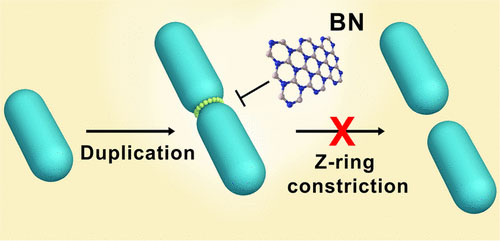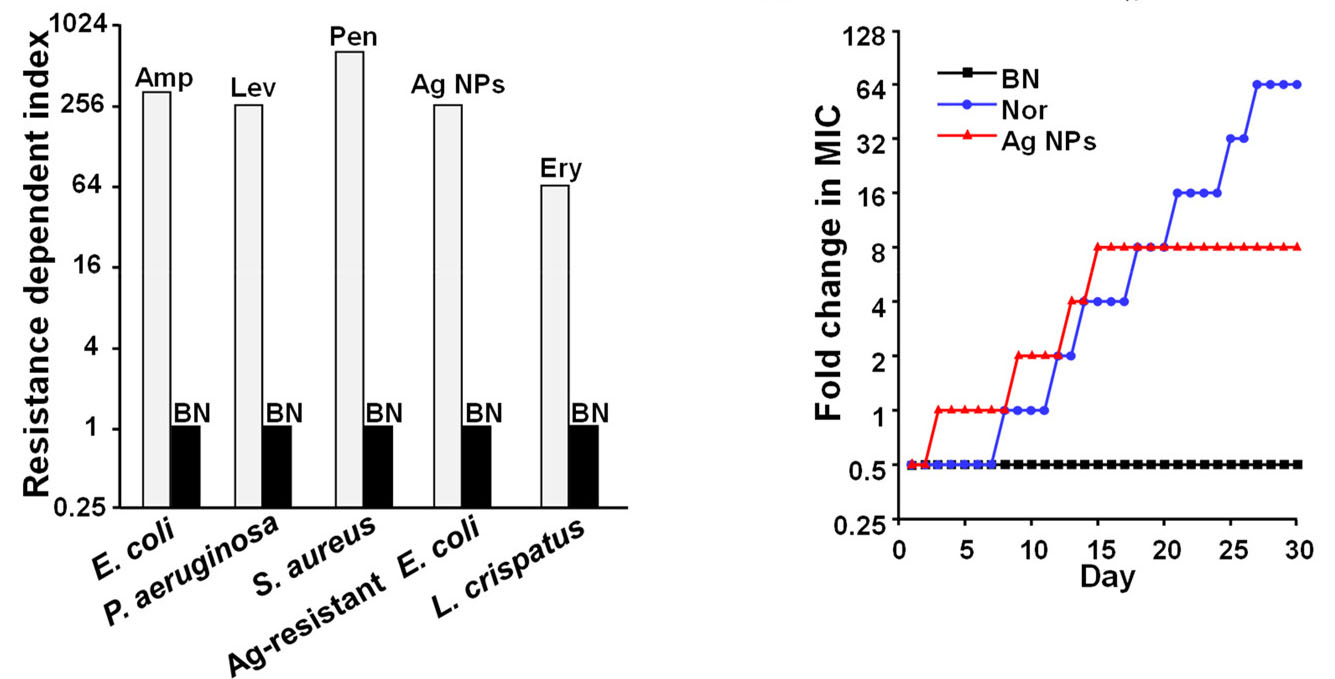| May 17, 2022 | |
Antibiotic-like boron nitride nanosheets for combating drug resistant bacteria |
|
| (Nanowerk Spotlight) The emergence of drug resistant pathogenic bacteria is rapidly spreading across the globe, jeopardizing the efficacy of antibiotics, which have been considered to be one of the most prominent game-changers in the history of medicine. | |
| These drugs have saved millions of lives from infections that were previously grievous and often life threatening, like bacterial endocarditis, bacterial meningitis and pneumococcal pneumonia, which now could be easily treated. | |
| Many decades after the first patients were treated with penicillin, one of the world's first antibiotics, bacterial infections have again become a threat. The antibiotic resistance crisis has been ascribed to the overuse and misuse of these medications, as well as a lack of motivation to develop new drugs by the pharmaceutical industry on account of the reduced economic incentives and challenging regulatory requirements. | |
| Alternative and novel strategies to overcome the inadequacy of current antibiotics, especially those with a different mode of action, such as the use of bacteriophages and antibodies, as well as other promising approaches like probiotics, lysins, and antimicrobial peptides, are needed to combat the antibiotic resistance crisis. | |
| There is also a dire need for concerted and innovative approaches in the field of novel antibiotic drug discovery and development. Moreover, application of nanotechnology in pharmaceuticals and microbiology is gaining importance to prevent the catastrophic ramifications of antibiotic resistance. | |
| A variety of innovative materials are being studied to evaluate their potential applications as antimicrobial agents. The typical examples are inorganic nanoparticles (NPs), namely Au NPs, Ag NPs, Cu NPs, SiO2 NPs, Iron oxide NPs, ZnO NPs, TiO2 NPs, MgO NPs and carbon-based nanomaterials, 2D materials (especially graphene), layered double hydroxides (LDHs), transition-metal dichalcogenides (TMDs), graphitic carbon nitride (g-C3 N4), MXenes, black phosphorus (BP), and their derivatives. Another class of materials belongs to antimicrobial polymers, which include polysaccharides, peptides, glycopeptide, chitosan, Poly-ε-lysine, and benzalkonium chloride. | |
| Recently, boron nitride (BN) has attracted a great deal of attention due to its physical and chemical properties, such as high-temperature resistance, oxidation resistance, heat conduction, electrical insulation, and neutron absorption. The unique lamellar, reticular, and tubular morphologies and physicochemical properties of BN make it attractive in the fields of adsorption, catalysis, hydrogen storage, thermal conduction, insulation, dielectric substrate of electronic devices, radiation protection, polymer composites, medicine, etc. (read more: ACS Omega, "The Synthesis and Characterization of h-BN Nanosheets with High Yield and Crystallinity"). | |
| Engineered nanomaterials exhibit distinctive killing mechanisms and tunable antibacterial activity in Gram-positive/negative (G+ /G−) strains. However, these antimicrobial nanomaterial agents often display similar killing pathways in microbes and mammalian cells, including lipid peroxidation and membrane damages, despite their different biological identifications. This has been clearly shown in the case of graphene oxide. | |
| It means that although nanosized antibacterial agents have been extensively explored, they cannot sufficiently discriminate between microbes and mammalian cells, which is likely to affect healthy cells and organs. Therefore, it is important to explore other antibiotic-like candidates for clinical uses. One of the prospective candidates is boron nitride nanosheets. | |
| In a new study, a team of researchers from China and Netherlands have shown that boron nitride (BN) nanosheets as a nano-antibacterial agent displays antibiotic-like activities (ACS Nano, "Antibiotic-Like Activity of Atomic Layer Boron Nitride for Combating Resistant Bacteria"). | |
 |
|
| Two-dimensional boron nitride (BN) nanosheets are reported to exhibit antibiotic-like activity to antimicrobial resistant bacteria. (Reprinted with permission from doi:10.1021/acsnano.1c11353, American Chemical Society) | |
| BN nanosheets were found to show potent antibacterial efficiency in five multidrug resistant bacteria strains, namely antimicrobial resistant E. coli, P. aeruginosa, S. aureus, L. crispatus, and Ag-resistant E. coli). Furthermore, they did not trigger the evolution of antimicrobial resistance in their long-term use and displayed excellent biocompatibility in mammals. | |
| In this work, the susceptibilities of five pairs of bacteria to BN nanosheets were assessed by the resistance-dependent index (RDI), which was estimated by the ratio of MICs (MIC is the lowest concentration of an antimicrobial agent that will inhibit the visible growth of a microorganism) of antibacterial agents against resistant strains vs parent strains (Figure 1). | |
 |
|
| Antibacterial effects of BN nanosheets. Left: RDIs of BN, Ag NPs, and antibiotics. Resistant dependence indexes of all biocides were calculated by their MICs against drug-resistant bacteria. Right: The evolutionary test of BN. AMR evolution test was employed by exposure of BN, Ag NPs, and Nor to antimicrobial resistant E. coli for 30 days under sub-MIC. The independent experiments were conducted three times. (Reprinted with permission from doi:10.1021/acsnano.1c11353, American Chemical Society) | |
| In contrast to other antimicrobial agents, BN exhibited persistent antibacterial activity in antimicrobial resistant E. coli, failing to trigger secondary resistance (Figure 2). These data indicate that BN nanosheets as an antibacterial agent of superbugs did not induce the antimicrobial resistance evolution. | |
| The authors point out that entirely different from other antibacterial nanoparticles, BN nanosheets displayed a distinctive killing mechanism, in which they could target key surface proteins (e.g., FtsP, EnvC, TolB) in cell division by Z-ring constriction impairment, allowing them to selectively combat bacteria without affecting mammalian cells and organs. | |
| The strong binding affinity of BN and recombinant EnvC protein demonstrated the capability of BN nanosheets to impact cell division. Unlike other reported antimicrobial nanoparticles, BN nanosheets have the capability to differentiate between mammalian cells and bacteria, as evidenced by the strong inhibition of bacteria proliferation and negligible toxicity in mammals. | |
| Notably, BN nanosheets had potent antibacterial effects in a lung infection model by P. aeruginosa, displaying a 2-fold increment of survival rate. | |
| Overall, these results suggest that BN nanosheets could be a promising nano-antibiotic to combat resistant bacteria and prevent AMR evolution. | |
|
By Yashwant Mahajan, Associate Editor, Nanowerk
|
|
|
Become a Spotlight guest author! Join our large and growing group of guest contributors. Have you just published a scientific paper or have other exciting developments to share with the nanotechnology community? Here is how to publish on nanowerk.com. |
|
